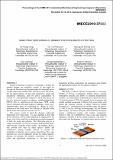| dc.contributor.author | Yang, Se Young | |
| dc.contributor.author | Petruczok, Christy | |
| dc.contributor.author | Choi, Hyungryul J. | |
| dc.contributor.author | Asatekin, Ayse | |
| dc.contributor.author | Barbastathis, George | |
| dc.contributor.author | Gleason, Karen K | |
| dc.date.accessioned | 2022-01-07T17:27:12Z | |
| dc.date.available | 2021-11-09T18:02:35Z | |
| dc.date.available | 2022-01-07T17:27:12Z | |
| dc.date.issued | 2010-11 | |
| dc.identifier.uri | https://hdl.handle.net/1721.1/138001.2 | |
| dc.description.abstract | Selective detection of explosive compounds is critical for national defense and homeland security. In this paper we describe the fabrication and demonstration of a chemical sensor capable of detecting nitroaromatic explosives in air. The device has the unique features of nano-scale dimensions, simple and inexpensive fabrication, and low power consumption. It consists of a nano-patterned conductive metal line placed on top of a patterned responsive polymer, poly(4-vinylpyridine) (P4VP). Due to polymer-solvent interactions, P4VP swells when it encounters the target analyte, producing a large stress. Detection takes place by monitoring the change in device resistance as the metal nano line deforms or fractures when P4VP swells and transfers mechanical stress. The sensors would be ideal for discreet, wide-scale deployment over large areas. It is also important to note that device sensitivity can be readily enhanced by scaling down the feature size of the metal line or adjusting the material properties of both the metal and polymer. The fabrication process is readily transferrable to a variety of organic and metal materials, improving the versatility of the sensors. The resulting devices may provide new ways to detect security threats and complement existing complex methods to increase the probability of detection and to reduce false alarms. The same approach may also be applicable outside the military/security domain, for example, for pollution monitoring, for factory safety and operational monitoring, or for food quality inspection; all these applications are contingent upon finding the appropriate polymers for the respective analytes. Copyright © 2010 by ASME. | en_US |
| dc.language.iso | en | |
| dc.publisher | ASME International | en_US |
| dc.relation.isversionof | 10.1115/imece2010-37802 | en_US |
| dc.rights | Article is made available in accordance with the publisher's policy and may be subject to US copyright law. Please refer to the publisher's site for terms of use. | en_US |
| dc.source | ASME | en_US |
| dc.title | Nano Fracture Chemical Sensor for Explosives Detection | en_US |
| dc.type | Article | en_US |
| dc.identifier.citation | Yang, Se Young, Petruczok, Christy, Choi, Hyungryul Johnny, Asatekin, Ayse, Barbastathis, George et al. 2010. "Nano Fracture Chemical Sensor for Explosives Detection." | en_US |
| dc.contributor.department | Massachusetts Institute of Technology. Department of Mechanical Engineering | en_US |
| dc.contributor.department | Massachusetts Institute of Technology. Department of Chemical Engineering | en_US |
| dc.contributor.department | Singapore-MIT Alliance in Research and Technology (SMART) | en_US |
| dc.eprint.version | Final published version | en_US |
| dc.type.uri | http://purl.org/eprint/type/ConferencePaper | en_US |
| eprint.status | http://purl.org/eprint/status/NonPeerReviewed | en_US |
| dc.date.updated | 2019-08-19T14:06:44Z | |
| dspace.date.submission | 2019-08-19T14:06:45Z | |
| mit.metadata.status | Publication Information Needed | en_US |
